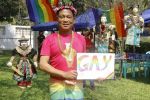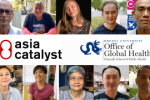Sex worker protest at the conference to demand decriminalization (Photo by Zhao Gang)
At the Vienna conference, thousands took to the streets to call for human rights to be integrated into AIDS policies and programs. They gathered in the Heldenplatz, a historic square in front of the Austrian Parliament building, to cheer the heads of UNAIDS, the Global Fund, and international AIDS activists such as Mark Heywood, and to dance and sing with pop singer Annie Lennox.
在维也纳的会议期间,成千上万的人上街集会,要求把人权列入到艾滋病的各项政策和项目中去。集会的地点是位于奥地利国会大楼前的英雄广场,一个具有历史意义的地方。人们相聚一起,为联合国艾滋病规划署署长、全球基金会会长和国际艾滋病活动家如马克·西伍德欢呼,和流行歌手安妮·列克斯一起载歌载舞。
While thousands marched and cheered,
Viennese police stood on the sidelines and watched, calmly. A few officers even
danced to the music. Some Chinese NGO colleagues expressed amazement at the sight
– but in fact, public protest is part of the venerable tradition of the
International AIDS Conference – even of the global AIDS movement.
In the early years of the HIV/AIDS
epidemic, when some commentators called it “the gay plague”, Western government
leaders refused to even mention the epidemic in public. There was no funding
for research, and no meeting to bring scientists and experts together at an International
AIDS Conference. These things came into existence because AIDS activists in
many countries staged protests demanding government funding for AIDS research.
Their protests and demands eventually led to the creation of the Global Fund,
national AIDS programs, and the International AIDS Conference.
At the AIDS Conference in Durban,
South Africa in 2000, AIDS activists staged massive protests to demand funding
for treatment. The existence of government and non-profit organizations
providing ARVs to 5.2 million people living with HIV/AIDS today is a direct
result of the Durban protests.
This year, guidelines for speakers at
the AIDS conference informed us that protests are a respected part of the
conference, nothing to get upset about. And indeed there were daily protests by
activists to demand increased funding for the Global Fund, decriminalization of
sex work, and to “zap” (that is, interrupt the presentations of) speakers who
represented countries that activists feel have not done enough to address
HIV/AIDS. Some protests were carefully planned in advance, while others were
more spontaneous. Often the protests crossed national, gender and identity
lines to bring diverse activists together. In many cases, the disruption only
took place long enough to make a point, and the conference program then
continued as planned.
Many aspects of the
AIDS movement that we now take for granted (such as the conference itself) came
about because of the work of AIDS activists in the past. That’s why we were
proud to join with colleagues from Asia, Africa, Europe, and Latin America to
call for human rights as part of the world’s response to HIV/AIDS – now more
than ever.
当这数千人在街上游行、欢呼时,维也纳的警方也站在路旁,冷静观望,有些警员甚至和音乐一起起舞,一些中国的非政府成员表达了他们对这一情景的惊奇感。事实上,当众抗议是国际艾滋病大会甚至是全球艾滋病运动优良传统的一部分。
在艾滋病流行早期,一些评论家称该病为”同性恋者的瘟疫”,西方政府首脑甚至拒绝在公共场所提起该疾病。没有任何的资金可以用于研究,也没有一个国际性的会议将科学家和专家聚到一起讨论。正是由于艾滋病活动家在许多国家发起抗议,要求政府提供资金用于艾滋病研究,现在这一切才形成。艾滋病活动家的抗议和要求最终促成了国际基金组织、国家艾滋病项目以及国际艾滋病大会的产生。
2000年在南非德班召开的国际艾滋病大会上,艾滋病活动家发起了大规模的抗议,要求提供资金用于治疗,现在,由政府和非盈利组织向520万艾滋病患者提供抗逆转录治疗就是德班抗议的直接成果。
今年,艾滋病大会发言者告知大众,抗议,是大会一个令人尊重的一部分,我们没有必要为此而感到沮丧。实际上,每天都有活动家发起抗议,要求增加对国际基金会的资金支持,对性工作的除罪化,并且他们会打断那些被认为为艾滋病做得还不够多的发言者的发言。有些抗议是经过事先仔细计划的,其他更多的是自发性的。这些抗议通常跨越国家、性别和身份的界限,将不同的活动家聚集在一起。在许多情况下,打断只持续能够说清一个方面观点的时间,然后大会按计划继续进行。
艾滋病运动的许多方面,如国际艾滋病大会等,我们现在认为理所当然,但他们是过去活动家们的工作成果。这也是我们会和来自亚洲、非洲、欧洲、拉丁美洲的同胞联合起来,一起呼吁将人权列入回应艾滋病的一部分,并为此而感到骄傲的原因,现在更是如此。




